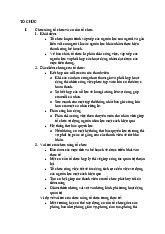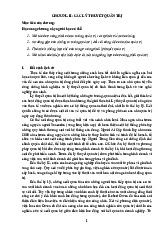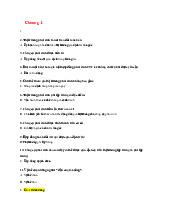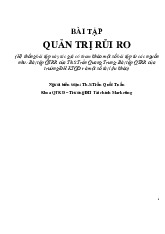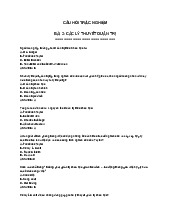



















Preview text:
lOMoARcPSD| 49670689
Câu hỏi trắc nghiệm tổng quan về logistics.
The trade-off that exists between carrying an ordering costs is that they respond in
opposite ways to the number of orders or size of orders. That is, an decrease in the
number of orders leads to.........Order costs and.....Carrying costs....................................16
Which of the following is NOT a method that the firm can apply to reduce inventory
through the supply chain?................................................................................................16
Use this information below to calculate the optimal order quantity:................................17
• Annual demand for backpacks is 45,000 units..........................................................17
• The cost to place an order is $250.............................................................................17
• The per unit cost of the item is $30.00.......................................................................17
• The annual holding rate is 27.5%..............................................................................17
Choose the closest answer................................................................................................17
Which of the following industry should apply theory of fast supply chain?.....................17
All of the following are suggestions for dealing with dead stock (inventory), except......17
Which of the following is an example of an ordering cost for products purchased from a
supplier?...........................................................................................................................18
If an item is ordered at its economic order quantity, the annual carrying cost should be: 18
Inventory turnover ratio shows how many times a firm turns over its inventory in an
accounting period. Faster turnovers are generally viewed as. because it indicates......in the
firm's business activities...................................................................................................18
What is meant by ABC analysis of inventory?.................................................................18
The ABC inventory control system categorizes inventory items into three groups, A, B,
and C. A items are given...priority, while C items have the.....priority. Prioritization may
be based on annual dollar usage, shelf life, or sales volume.............................................19
Which concept refers to the storage of raw materials and movement to the producer?....19
The … approach indicates that a company's objectives can be realized by recognizing the
mutual interdependence of major functional areas...........................................................19
The................ approach mentions all relevant cost items are considered simultaneously
when making decision......................................................................................................19
Which does include in warehousing activity?..................................................................20 lOMoARcPSD| 49670689
"Some companies use suitable mode of transportation with an acceptable cost to meet
customer delivery requirements as well as increase satisfaction for the customer". As
such, the company could be considered...........................................................................20
Logistics costs of bubble manufacturing industry will be compared with logistics costs of
automobile manufacturing industry..................................................................................20
………….. refers to an item that the firm holds with a very large amount of quantity at
the same time there is no demand for it............................................................................21
In the past, which field does logistics not connect with?..................................................21
Each of the following is a component of inventory carrying cost except:........................21
…….. refers to stocks of goods and materials that are maintained for many purposes....21
……... products refer to those that customers view as being able to fill the same need or
want as another product....................................................................................................21
Service parts logistics has decreased in importance in recent years.................................22
Lean manufacturing focuses on the elimination of waste.................................................22
The EOQ is the point at which carrying costs equal ordering costs.................................22
The higher the average cost of a stockout, the more likely a company is going to want to
hold safety stock...............................................................................................................22
Safety stock is also referred to as cycle stock...................................................................22
………. is generally the fastest form of transportation for shipments exceeding 600 miles.
.........................................................................................................................................22
Consignees are ……........................................................................................................23
Which of the following is not likely to move by air transportation?................................23
The primary advantage for motor carriers is ………........................................................23
……… is the most reliable form of transportation...........................................................23
……….. pipelines carry crude oil from gathering-line concentration points to the oil
refineries..........................................................................................................................24
……….. have a level of market concentration and dominance that is not found in the
other modes......................................................................................................................24
What container size is often used to rank water ports and measure containership capacity?
.........................................................................................................................................24
Shippers' associations ……..............................................................................................24
A transportation broker ……...........................................................................................25 lOMoARcPSD| 49670689
Distribution centres emphasize……….. and their primary purpose is to maximize.........25
……… focuses on ensuring products reach the consumers through a network of
distributors, warehouses and retailers...............................................................................25
The warehousing function that combines the several small shipments to a specific market
area is ………..................................................................................................................25
Throughput refers to ………............................................................................................26
What is considered to be the biggest drawback to public warehousing?..........................26
…… refers to breaking a homogeneous supply into smaller lots.....................................26
……… bringing together similar stocks from different sources......................................26
………… warehousing is owned or occupied on a long-tern lease by the firm using them
.........................................................................................................................................27
Warehouses emphasize………….....................................................................................27
Product density refers to a product's ………....................................................................27
………. refers to materials used for the containment, protection, handling, delivery, and
presentation of goods.......................................................................................................27
……… is the science, art and technology of enclosing or protecting products for
distribution, storage, sale and use.....................................................................................28
Which of the following is the wrong definition of TEU?.................................................28
Which of the given reasons, is NOT a valid reason for packaging of food items?...........28
Which of the following is false?.......................................................................................28
Each of the following is a shipping hazard that a package may be exposed to except:....29
What is dunnage?.............................................................................................................29
………… refers to the short distance movement that takes place within a plant,
distribution or warehouse.................................................................................................29
………… are required when a continuous flow of material/product operating over a long
period...............................................................................................................................29
Packages on the pallets can be moved using ……….......................................................30
The vast majority of pallets are made of ………..............................................................30
Which one of the following is NOT classified as a manual handling activity?................30
Conveyor belt facilitate continuous movement of material over a …….. route...............30
The major advantage of the unit load is that it enables mechanical devices to be
substituted for manual labor.............................................................................................31 lOMoARcPSD| 49670689
1. wh emphasize .... and their primary purpose is to maximize ?.....................................31
2…. is a process where a product is received in a facility and shipped at the earliest time,
without storage.................................................................................................................31
3. … wh is owned or occupied on a long-term lease by the firm using them...................31
4. …. Is bringing together similar stocks from different sources......................................31
5. …. Refers to breaking a homogeneous supply into smaller lots...................................31
6. what is considered to be the biggest drawback to public wh?......................................31 7. throughput refers to
….................................................................................................31
8. the wh function that combines the several small shipments to a specific market area is?
.........................................................................................................................................31
9. … focuses on ensuring products reach the consumers through a network of
distributors, wh and retailers?..........................................................................................32
10. distribution centres emphasize … and their primary purpose is to maximize.............32
TRẮC NGHIỆM QUIZLET OVERVIEW OF LOGISTICS AND SUPPLY CHAIN.....32
supply chain management................................................................................................32
supply chain mission........................................................................................................32
Primary key activities.......................................................................................................32
Secondary key activities...................................................................................................32
transport strategy..............................................................................................................32
inventory strategy.............................................................................................................32
location strategy...............................................................................................................32
customer service goals.....................................................................................................32
transportation and inventory.............................................................................................32
transportation and inventory costs....................................................................................32
maximize return on logistics assets (ROLA)....................................................................33
significance of logistics....................................................................................................33
objectives of logistics strategy.........................................................................................33
levels of logistical planning..............................................................................................33
4 problem areas of SC planning.......................................................................................33
total cost concept..............................................................................................................33 lOMoARcPSD| 49670689
differentiated distribtuino.................................................................................................33
mixed strategy..................................................................................................................33
postponement...................................................................................................................33
shipment consolidation.....................................................................................................33
product standardizaiton....................................................................................................33
six consepts for logistics strategy formulation.................................................................33 7
principles of SCM.........................................................................................................34
Logistics...........................................................................................................................34
Reverse flow....................................................................................................................34
Amazon............................................................................................................................34
Macroeconomic impacts..................................................................................................34
Possession utility..............................................................................................................34
Form utility......................................................................................................................35
Place utility......................................................................................................................35
Time utility.......................................................................................................................35
Total Logistics Cost.........................................................................................................35
U.S. Percent of GDP........................................................................................................35
5 Modes of Transportation...............................................................................................35
Friction of Distance..........................................................................................................36
Increased importance in logistics.....................................................................................36
Digitalization of commerce and emergence of 3D printing..............................................36
Goal of logistics...............................................................................................................36
The Bill of Rights.............................................................................................................36
Work of logistics occurs...................................................................................................36
Upstream..........................................................................................................................37
Downstream.....................................................................................................................37
Balanced inbound and outbound......................................................................................37
Heavy inbound.................................................................................................................37
Heavy outbound...............................................................................................................37
Reverse bound..................................................................................................................37
Is it Inbound or Outbound?..............................................................................................37 lOMoARcPSD| 49670689
Cost-Tradeoffs.................................................................................................................37
Total Logistics Concept...................................................................................................37
Marketing Mix.................................................................................................................37
Logistics Mix...................................................................................................................38
Place/Customer Service Levels........................................................................................38
Inventory Carrying Cost...................................................................................................38
Lot Quantity Costs.........................................................................................................38
Order Processing and Information Costs...................................................................38
Warehousing Costs.......................................................................................................39
Transportation Costs.....................................................................................................39
Most important logistics element.................................................................................39
Supply Chain Operations (SCO).................................................................................39
Supply Chain Management (SCM).............................................................................39
Supply Chain Network Structure.................................................................................40
Supply Chain Management Process..........................................................................40
Supply Chain Business Processes.............................................................................40
Motivation for SCM........................................................................................................40
Enablers of SCM...........................................................................................................40
100% Guarantee policies.............................................................................................41
Economic Utility.............................................................................................................41
Mass Logistics...............................................................................................................41
Tailored Logistics...........................................................................................................41
Humanitarian Logistics.................................................................................................41
Disintermediation...........................................................................................................41
Container........................................................................................................................41
Systems Approach........................................................................................................42
Materials Management.................................................................................................42
Physical Distribution......................................................................................................42
Intrafunctional Logistics................................................................................................42
Total Cost Approach.....................................................................................................42 lOMoARcPSD| 49670689
Cost Trade-offs..............................................................................................................42
Interaction with other departments..............................................................................42
Co-Branding...................................................................................................................42
Landed Costs.................................................................................................................43
Stockouts........................................................................................................................43
Marketing Channels......................................................................................................43
Ownership Channel.......................................................................................................43
Negotiation Channel......................................................................................................43
Financing Channel........................................................................................................43
Promotions Channel......................................................................................................43
Logistics Channel..........................................................................................................43
Sorting Function.............................................................................................................43
Sorting Out.....................................................................................................................43
Accumulating..................................................................................................................44
Allocating........................................................................................................................44
Assorting.........................................................................................................................44
Freight Forwarder..........................................................................................................44
Supply Chain..................................................................................................................44
SCOR Model..................................................................................................................44
GSCF Model..................................................................................................................44
Lean Supply Chain........................................................................................................44
Leagility...........................................................................................................................45
Bullwhip Effect...............................................................................................................45
Supply Chain Collaboration.........................................................................................45
Supply Chain Partnership.............................................................................................45
Third-Party Logistics.....................................................................................................45
Fourth-Party Logistics...................................................................................................45
SCM Troubles................................................................................................................45
Integrating Supply Chain Organization.......................................................................46 lOMoARcPSD| 49670689
Quiz 1 Review:...............................................................................................................46
Supply Chain Management..............................................................................................46
logistic management.........................................................................................................46
inbound logistics..............................................................................................................46
outbound logistic..............................................................................................................47
Contemporary business environment...............................................................................47
Key LSCM driving forces................................................................................................47
Integrated Supply Chain flow...........................................................................................47
Essence of LCSM.............................................................................................................47
Modern Logistics System.................................................................................................47
Modern Supply Chain......................................................................................................47
Upstream Supply Chain...................................................................................................47
downstream supply chain.................................................................................................47
international logistic management....................................................................................47
Storage facility.................................................................................................................48
transit shed.......................................................................................................................48
Hold-on-Dock Storage.....................................................................................................48
public warehouses............................................................................................................48
bonded warehouse............................................................................................................48
Port & logistic infrastructure............................................................................................48
Transportation mode selection.........................................................................................48
Distrubution.....................................................................................................................48
Efficient...........................................................................................................................48
The evolution of logistics.................................................................................................48
Physical distrubution management...................................................................................49
Integrated logistics...........................................................................................................49
Integrated logistics (focus, methodologies, organization, awareness)..............................49
Supply chain management - CSCPM definition...............................................................49
Logistics managment - CSCPM definition.......................................................................50
Supply chain management (focus, methodologies, organization, awareness)..................50
Supply chain based competition (stretegic approaches and implications)........................50 lOMoARcPSD| 49670689
The three stacks of Logistics management.......................................................................51
Logistics execution...........................................................................................................51
Logistics planning............................................................................................................51
Logistics system design and strategy...............................................................................51
From production line to consumer:..................................................................................52
Movement of finished products:.......................................................................................52
Integrated logistics - Integration.......................................................................................52
Integrated logistics - Plan, implement and control:..........................................................52
Integrated logistics - From point of origin to point of consumption:................................52
Logistics and the supply chain management....................................................................52
What does cupply chain management include?................................................................52
What is the amount of inventory (or finished products) in the warehouses of
manufacturers and retailers? (FMCG)..............................................................................52
what does FMCG stand for?.............................................................................................53
What is the average value of the on-shelf availability in the stores of the retailers?........53
What is the average saturation of transportation from manufacturers to deliver to
retailers?...........................................................................................................................53
What are the three stacks of logistics management?........................................................53
Decision level: 1. operational = Logistics Execution 2. Tactical = Logistics Planning 3.
Strategic = Logistics System Design and Strategy...........................................................53
1. Logistics execution.......................................................................................................53
2. Logistics planning........................................................................................................53
3. Logistics system design and strategy aims at defining:................................................53
Why is logistics & SCM important?................................................................................54
What are key performance indicators (KPIs)?..................................................................54
order fufillment deliverables are......................................................................................54
"seven rights"...................................................................................................................54
TRẮC NGHIỆM QUIZZLET CHƯƠNG INVENTORY MANAGEMENT...................54
Type of Inventories..........................................................................................................55
What happens to production AND sales if you don't have the inventory you need?........55 lOMoARcPSD| 49670689
Dependent demand...........................................................................................................55
What is Safety Stock?......................................................................................................55
take advantage of order cycles.........................................................................................55
hedge against price increases...........................................................................................55
Inadequate control of inventory results in:.......................................................................55
Problems with understocking. Understocking inventory results in :................................55
Problems with overstocking. Overstocking inventory causes problems with:..................55
wasting money and can't use it anywhere else..................................................................56
Inventory Management....................................................................................................56
periodic systems...............................................................................................................56
perpetual systems.............................................................................................................56
forecast of demand...........................................................................................................56
knowledge of lead times...................................................................................................56
Holding costs...................................................................................................................56
how much does it cost to store inventory?.......................................................................56
ordering costs...................................................................................................................56
shortage costs...................................................................................................................56
classification systems.......................................................................................................57
What do EOQ Models identify ?......................................................................................57
What is The Basic EOQ model is used to identify ?.........................................................57
WHY does Large Order - lower ordering cost, but higher carrying cost?........................57
WHY does Small Order - higher ordering cost, but lower carrying cost?........................57
Quantity discounts............................................................................................................57
Reorder Point...................................................................................................................57
What are the components that make up inventory............................................................57
Raw materials...................................................................................................................57
WIP..................................................................................................................................58
Finished Goods................................................................................................................58
Functions of inventory.....................................................................................................58
Dysfunctions of inventory................................................................................................58 lOMoARcPSD| 49670689
Inventory costs.................................................................................................................58
Types of inventory costs..................................................................................................58
Holding or carrying cost...................................................................................................59
Total carrying cost formula..............................................................................................59
Ordering cost....................................................................................................................59
Total ordering cost formula..............................................................................................59
Inventory management objectives....................................................................................59
Service objective..............................................................................................................59
Cost objective...................................................................................................................59
Two problems addressed by inventory.............................................................................59
EOQ.................................................................................................................................60
EOQ model assumptions..................................................................................................60
Inventory at the Macro Level...........................................................................................60
Inventory at the firm level................................................................................................60
Inventory management goals............................................................................................60
Push system of inventory control.....................................................................................60
How the push system works.............................................................................................61
Benefits of push system...................................................................................................61
Issues with push system...................................................................................................61
Materials requirements planning......................................................................................61
Key elements of MRP......................................................................................................61
Master production schedule.............................................................................................61
Bill of materials................................................................................................................62
Pull inventory control system...........................................................................................62
How a pull system works.................................................................................................62
Advantage of pull system.................................................................................................62
Disadvantage of pull system............................................................................................62
US post WWII..................................................................................................................62
What led to the development of the JIT system................................................................63
Japanese approach to operations......................................................................................63 lOMoARcPSD| 49670689
How to control production...............................................................................................63
What does JIT attempt to do.............................................................................................63
JIT system........................................................................................................................64
Kanban system.................................................................................................................64
How the Kanban system works........................................................................................64
Vendor-managed inventory..............................................................................................64
CPRF................................................................................................................................64
ABC analysis...................................................................................................................65
Preto's rule (80-20 rule)....................................................................................................65
Application of Pareto rule................................................................................................65
ABC classification system...............................................................................................65
80-20 rule and inventory classification............................................................................66
Inventory Management....................................................................................................66
Uncertainty In Demand....................................................................................................66
Uncertainty in Supply......................................................................................................66
Uncertainty Production....................................................................................................66
Transportation..................................................................................................................66
Deterministic model.........................................................................................................67
Cycle time........................................................................................................................67
Average Inventory Level..................................................................................................67
Lead Time........................................................................................................................67
Reorder Point (r)..............................................................................................................67
Increase in Order Quantity...............................................................................................67
Economic Order Quantity................................................................................................67
Costs in the Economic Order Quantity.............................................................................67
Order per Year formula....................................................................................................67
Annual Order Cost...........................................................................................................67
Average Inventory Level..................................................................................................68
Average Inventory Value.................................................................................................68
Annual Inventory Carrying Cost......................................................................................68
EOQ Model Assumptions................................................................................................68 lOMoARcPSD| 49670689
Safety Stock.....................................................................................................................68
ABC Analysis..................................................................................................................68
Pareto's Rule (80-20 Rule)...............................................................................................68
Inventory Turns................................................................................................................69
Inventory Management Methods......................................................................................69
Dependent Demand..........................................................................................................69
Independent Demand.......................................................................................................69
Pull Systems.....................................................................................................................69
Push Systems...................................................................................................................69
Fixed Order Quantity Approach.......................................................................................69
Fixed Order Interval Approach........................................................................................70
Just in Time......................................................................................................................70
Kanban.............................................................................................................................70
Fundamental Concepts of JIT...........................................................................................70
JIT Operations..................................................................................................................70
JIT Systems......................................................................................................................70
JJIT 6 major differences...................................................................................................70
JIT vs TIM traditional inv, management..........................................................................71
(MRP) Materials Requirement Planing............................................................................71
MRP Goals.......................................................................................................................71
Key elements of an MRP.................................................................................................71
Advantages of MRP.........................................................................................................71
Disadvantages of MRP.....................................................................................................72
materials management......................................................................................................72
independent requirements................................................................................................72
stochastic..........................................................................................................................72
dependent requirements....................................................................................................72
deterministic.....................................................................................................................72
material requirements planning (MRP)............................................................................72
make to order production (MTO).....................................................................................72
make to stock production (MTS)......................................................................................73 lOMoARcPSD| 49670689
inventory management.....................................................................................................73
stock keeping unit (SKU).................................................................................................73
batches and lots................................................................................................................73
inventory management system.........................................................................................73
material types...................................................................................................................73
reverse logistics................................................................................................................73
cost of ordering inventory................................................................................................73
cost of holding inventory..................................................................................................74
average cost of capital......................................................................................................74
cost of stockouts...............................................................................................................74
stockout............................................................................................................................74
critical materials...............................................................................................................74
non-critical materials........................................................................................................74
unrestricted inventory.......................................................................................................74
quality inspection inventory.............................................................................................74
blocked inventory.............................................................................................................74
in-transit inventory...........................................................................................................75
fixed lot sizes...................................................................................................................75
replenishment to the maximum stock level......................................................................75
Economic Order Quantity (EOQ).....................................................................................75
inventory control models..................................................................................................75
reorder point model (Q-model or fixed order quantity model).........................................75
reorder point (ROP)..........................................................................................................76
total replenishment lead time (L).....................................................................................76
order processing time.......................................................................................................76
planned delivery time.......................................................................................................76
goods receipt processing time..........................................................................................76
safety stock.......................................................................................................................76
service level (SL).............................................................................................................76
stockout risk (SR).............................................................................................................76
constant order-period model (P-model)............................................................................76 lOMoARcPSD| 49670689
single period inventory model (newsboy problem)..........................................................76
overbooking.....................................................................................................................77
warehouse management systems (WMS).........................................................................77
multi-echelon distribution system....................................................................................77
material movement...........................................................................................................77
goods receipt....................................................................................................................77
goods issue.......................................................................................................................77
stock transfer....................................................................................................................77
transfer posting.................................................................................................................77
Inventory Management....................................................................................................78
Importance of inventory...................................................................................................78
Functions of inventory.....................................................................................................78
Two basic questions in inventory control.........................................................................78
Three V Model of Inventory Managment.........................................................................78
Types of Inventory...........................................................................................................78
The Materials Flow Cycle................................................................................................78
ABC Analysis..................................................................................................................79
Basic EOQ Model............................................................................................................79
Minimizing costs..............................................................................................................79
Robust model...................................................................................................................79
Reorder points..................................................................................................................79
Probabilistic models and safety stock...............................................................................79
Other Probabilistic Models...............................................................................................80
Single-Period Model........................................................................................................80
Fixed-Period (P) Systems.................................................................................................80
inventory..........................................................................................................................80
independent demand items...............................................................................................80
Types of Inventory...........................................................................................................80
Functions of Inventory.....................................................................................................81
Objectives of Inventory Control.......................................................................................81
Effective inventory management requires:.......................................................................81 lOMoARcPSD| 49670689
Inventory Counting Systems............................................................................................81
Periodic System................................................................................................................81
perpetual inventory system...............................................................................................81
Inventory Counting Technologies....................................................................................81
Inventory Costs................................................................................................................82
ABC Classification System..............................................................................................82
cycle counting (periodic system)......................................................................................82
EOQ Models....................................................................................................................82
Basic EOQ Model............................................................................................................83
Deriving EOQ..................................................................................................................83
Quantity Discount............................................................................................................83
reorder point.....................................................................................................................83
determinants of the reorder point.....................................................................................83
reorder point: under uncertainty.......................................................................................83
safety stock.......................................................................................................................83
service level.....................................................................................................................84
The amount of safety stock that is appropriate for a given situation depends upon:.........84
TRẮC NGHIỆM QTRI LOG (UEF)
The trade-off that exists between carrying an ordering costs is that they respond
in opposite ways to the number of orders or size of orders. That is, an decrease
in the number of orders leads to.........Order costs and.....Carrying costs. a. higher; higher b. lower; higher c. higher; lower d. lower; lower
Which of the following is NOT a method that the firm can apply to reduce
inventory through the supply chain? lOMoARcPSD| 49670689
a. the use of premium transportation b. demand-pull
C. the firm does not deal with slower-moving products
d. break orders with smaller quantities, and place frequently
Use this information below to calculate the optimal order quantity:
• Annual demand for backpacks is 45,000 units
• The cost to place an order is $250
• The per unit cost of the item is $30.00
• The annual holding rate is 27.5% Choose the closest answer. a. 711 units b. 834 units c. 920 units d. 1651 units
Which of the following industry should apply theory of fast supply chain? a. Gasoline industry b. Electrical industry c. Food industry d. Fuel industry
All of the following are suggestions for dealing with dead stock (inventory), except a. aggressive marketing b. donate to charities c. throw it away lOMoARcPSD| 49670689 d. All answers are correct
Which of the following is an example of an ordering cost for products purchased from a supplier?
a. the cost of buying insurance
b. the cost of pilferage while in storage
c. the cost of clerical staff for preparing the purchase
d. the cost associated with damaged products due to out of date.
If an item is ordered at its economic order quantity, the annual carrying cost should be:
a. the square root of the annual ordering cost.
b. slightly less than the annual ordering cost.
c.equal to the annual ordering cost.
d. twice the annual purchase price.
Inventory turnover ratio shows how many times a firm turns over its inventory
in an accounting period. Faster turnovers are generally viewed as. because it
indicates......in the firm's business activities. a. negative; efficiency b. negative; instability c. positive; efficiency d. positive; inefficiency
What is meant by ABC analysis of inventory?
a. ABC analysis of inventory is an alternative to the EOQ model
b. All inventories are not of equal value to a firm and, as a result, all
inventory should not be managed in the same Way.
C. All inventories are equal value to a firm and, as a result, all inventory
should be managed in the same way. lOMoARcPSD| 49670689
d. ABC analysis of inventory is synonymous with vendor-managed inventory
The ABC inventory control system categorizes inventory items into three
groups, A, B, and C. A items are given...priority, while C items have
the.....priority. Prioritization may be based on annual dollar usage, shelf life, or sales volume. a. highest; medium b. lowest; highest c. highest; lowest d. medium; lowest
Which concept refers to the storage of raw materials and movement to the producer? Materials management Physical distribution Inbound logistics Supply chain management
The … approach indicates that a company's objectives can be realized by
recognizing the mutual interdependence of major functional areas. a. rhochrematics b. supply chain c. systems d. interfunctionality
The................ approach mentions all relevant cost items are considered
simultaneously when making decision. lOMoARcPSD| 49670689 a. systems B. total cost c.interfunctionality d. rhochrematics
Which does include in warehousing activity?
a. Basing on featured characteristics of product, the firm will select the suitable method to store product.
b. Select the carrier who can provide lower freight for the firm
c. Estimate product demand in the future
d. Use appropriate equipment to load/unload the products
"Some companies use suitable mode of transportation with an acceptable cost
to meet customer delivery requirements as well as increase satisfaction for
the customer". As such, the company could be considered
a. Productivity but not effective.
b. Effective but not efficient.
c. Efficient but not effective.
d. Reengineering but not productivity.
Logistics costs of bubble manufacturing industry will be compared with
logistics costs of automobile manufacturing industry. a. equal b. lower
